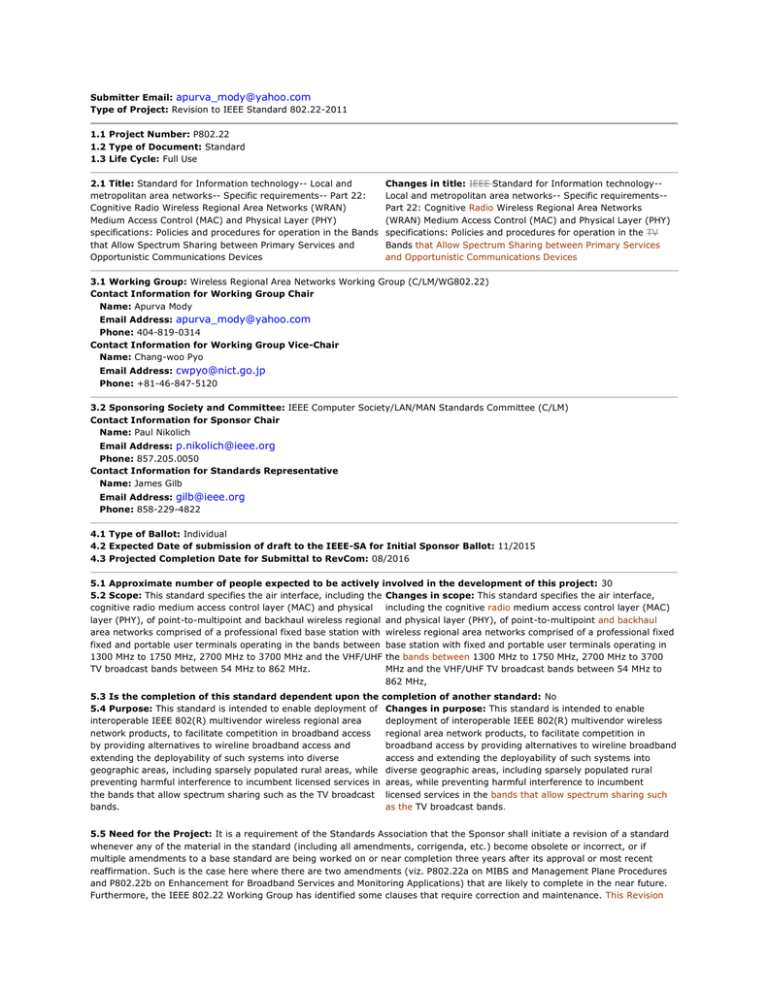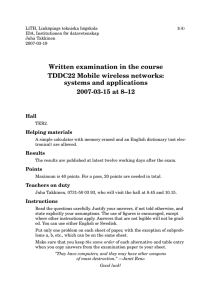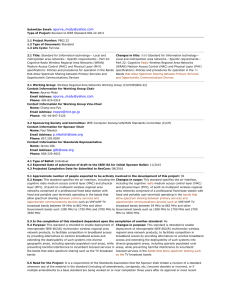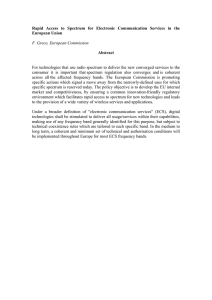Document 17742300
advertisement

Submitter Email: apurva_mody@yahoo.com Type of Project: Revision to IEEE Standard 802.22-2011 1.1 Project Number: P802.22 1.2 Type of Document: Standard 1.3 Life Cycle: Full Use 2.1 Title: Standard for Information technology-- Local and metropolitan area networks-- Specific requirements-- Part 22: Cognitive Radio Wireless Regional Area Networks (WRAN) Medium Access Control (MAC) and Physical Layer (PHY) specifications: Policies and procedures for operation in the Bands that Allow Spectrum Sharing between Primary Services and Opportunistic Communications Devices Changes in title: IEEE Standard for Information technology-Local and metropolitan area networks-- Specific requirements-Part 22: Cognitive Radio Wireless Regional Area Networks (WRAN) Medium Access Control (MAC) and Physical Layer (PHY) specifications: Policies and procedures for operation in the TV Bands that Allow Spectrum Sharing between Primary Services and Opportunistic Communications Devices 3.1 Working Group: Wireless Regional Area Networks Working Group (C/LM/WG802.22) Contact Information for Working Group Chair Name: Apurva Mody Email Address: apurva_mody@yahoo.com Phone: 404-819-0314 Contact Information for Working Group Vice-Chair Name: Chang-woo Pyo Email Address: cwpyo@nict.go.jp Phone: +81-46-847-5120 3.2 Sponsoring Society and Committee: IEEE Computer Society/LAN/MAN Standards Committee (C/LM) Contact Information for Sponsor Chair Name: Paul Nikolich Email Address: p.nikolich@ieee.org Phone: 857.205.0050 Contact Information for Standards Representative Name: James Gilb Email Address: gilb@ieee.org Phone: 858-229-4822 4.1 Type of Ballot: Individual 4.2 Expected Date of submission of draft to the IEEE-SA for Initial Sponsor Ballot: 11/2015 4.3 Projected Completion Date for Submittal to RevCom: 08/2016 5.1 Approximate number of people expected to be actively involved in the development of this project: 30 5.2 Scope: This standard specifies the air interface, including the Changes in scope: This standard specifies the air interface, cognitive radio medium access control layer (MAC) and physical including the cognitive radio medium access control layer (MAC) layer (PHY), of point-to-multipoint and backhaul wireless regional and physical layer (PHY), of point-to-multipoint and backhaul area networks comprised of a professional fixed base station with wireless regional area networks comprised of a professional fixed fixed and portable user terminals operating in the bands between base station with fixed and portable user terminals operating in 1300 MHz to 1750 MHz, 2700 MHz to 3700 MHz and the VHF/UHF the bands between 1300 MHz to 1750 MHz, 2700 MHz to 3700 TV broadcast bands between 54 MHz to 862 MHz. MHz and the VHF/UHF TV broadcast bands between 54 MHz to 862 MHz, 5.3 Is the completion of this standard dependent upon the completion of another standard: No 5.4 Purpose: This standard is intended to enable deployment of Changes in purpose: This standard is intended to enable interoperable IEEE 802(R) multivendor wireless regional area deployment of interoperable IEEE 802(R) multivendor wireless network products, to facilitate competition in broadband access regional area network products, to facilitate competition in by providing alternatives to wireline broadband access and broadband access by providing alternatives to wireline broadband extending the deployability of such systems into diverse access and extending the deployability of such systems into geographic areas, including sparsely populated rural areas, while diverse geographic areas, including sparsely populated rural preventing harmful interference to incumbent licensed services in areas, while preventing harmful interference to incumbent the bands that allow spectrum sharing such as the TV broadcast licensed services in the bands that allow spectrum sharing such bands. as the TV broadcast bands. 5.5 Need for the Project: It is a requirement of the Standards Association that the Sponsor shall initiate a revision of a standard whenever any of the material in the standard (including all amendments, corrigenda, etc.) become obsolete or incorrect, or if multiple amendments to a base standard are being worked on or near completion three years after its approval or most recent reaffirmation. Such is the case here where there are two amendments (viz. P802.22a on MIBS and Management Plane Procedures and P802.22b on Enhancement for Broadband Services and Monitoring Applications) that are likely to complete in the near future. Furthermore, the IEEE 802.22 Working Group has identified some clauses that require correction and maintenance. This Revision project merges the P802.22a Amendment on MIBs and Management Plane Procedures. It also merges the P802.22b amendment on Enhancement for Broadband Services and Monitoring Applications. The revision project makes technical corrections to various Clauses. The revision project provides new clauses. These new clauses specify ways in which the IEEE 802.22 Standard may be used in other frequency bands that allow spectrum sharing. It also introduces new clauses specifying how 802.22 systems can be used for broadcasting and backhaul applications. 5.6 Stakeholders for the Standard: Manufacturers and users of semiconductor, personal computer, enterprise networking devices, consumer electronic devices, home networking equipment, mobile devices, wireless internet service providers etc. Intellectual Property 6.1.a. Is the Sponsor aware of any copyright permissions needed for this project?: No 6.1.b. Is the Sponsor aware of possible registration activity related to this project?: No 7.1 Are there other standards or projects with a similar scope?: Yes If Yes please explain: IEEE P802.11AF, P802.15.4m, IEEE P1900.7 and answer the following Sponsor Organization: IEEE 802 and DySPAN-SC Project/Standard Number: IEEE P802.11AF, P802.15.4m, IEEE P1900.7 Project/Standard Date: Project/Standard Title: IEEE P802.11AF: IEEE Standard for Information Technology - Telecommunications and Information Exchange Between Systems - Local and Metropolitan Area Networks - Specific Requirements - Part 11: Wireless LAN Medium Access Control (MAC) and Physical Layer (PHY) Specifications - Amendment: TV White Spaces Operation P802.15.4m: IEEE Standard for Local and Metropolitan Area Networks Part 15.4: Low Rate Wireless Personal Area Networks (LR-WPANs) Amendment: TV White Space Between 54 MHz and 862 MHz Physical Layer IEEE P1900.7: Radio Interface for White Space Dynamic Spectrum Access Radio Systems Supporting Fixed and Mobile Operation 7.2 Joint Development Is it the intent to develop this document jointly with another organization?: No 8.1 Additional Explanatory Notes (Item Number and Explanation): Since 2005, when the 802.22 PAR was first submitted and approved, FCC, NTIA and other regulators have broadened their horizons for cooperative spectrum sharing approaches in order to optimize spectrum utilization. [1]. FCC/ NTIA are in the process of opening new spectrum bands which specifically require multilevels of regulated users to share the spectrum utilizing cognitive radio behavior. For our purposes, we define spectrum sharing as a mechanism which ensures that primary services are protected from interference while allowing other opportunistic devices to share the spectrum. While these new bands have been specified by the FCC for the United States, they may be different in other countries. The intention of this PAR is to align the current 802.22 technology with emerging regulations. The fundamental assumption behind the operation of IEEE 802.22 systems is that spectrum is shared with primary users. Hence the shared spectrum may or may not be available at all times and at all the locations. The radio will have to automatically change its characteristics and behavior to operate in appropriate alternate spectrum as directed by the cognitive sharing mechanism (e. g. database or a spectrum access system, sensing or beaconing). Thus 802.22 systems are highly applicable for use in bands that allow spectrum sharing such as the radar bands. This revision may also introduce new clauses on how 802.22 systems can be used in other ways. For example, backhaul and broadcast services have now been recognized as a critical components to serve rural and remote areas in developed and developing countries. These new clauses will describe the requirements, architecture and specifications for the use of 802.22 systems for such uses. Following sections of the PAR form have been changed from the original 802.22 PAR Form that was approved by the NESCOM: Title, Scope, Purpose and the Need clauses have changed. [1] President’ s Council of Advisors on Science and Technology Report – Realizing Full Potential of the Government Held Spectrum to Spur Economic Growth. http://www.whitehouse.gov/sites/default/files/microsites/ostp/pcast_spectrum_report_final_july_20_2012.pdf





